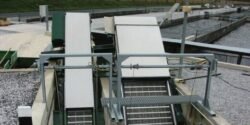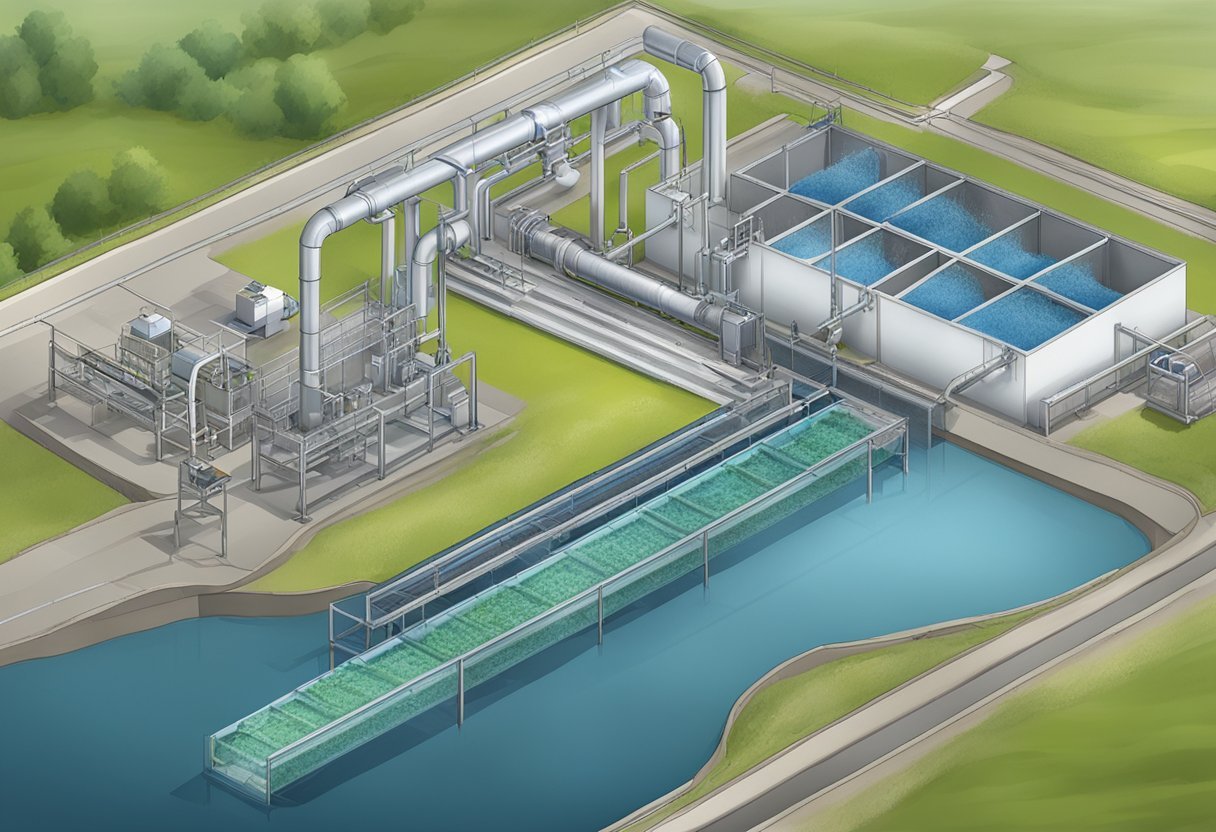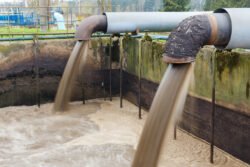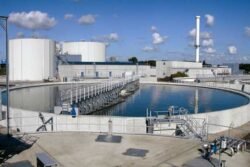Preliminary Treatment

Preliminary wastewater treatment is a critical first step in the water treatment process, designed to prepare the inflow for subsequent treatment stages. This stage involves the removal of coarse solids and other large materials that could potentially cause damage to pumps and other treatment equipment. DDoing so helps protect the intricate processes that follow, such as biological treatment and secondary clarification. A comprehensive preliminary treatment usually includes screening and grit removal alongside other methods, such as comminution, which aids in breaking down large objects into smaller, more manageable pieces.
The importance of an effective preliminary treatment system cannot be overstated, as it ensures the efficient operation of the subsequent treatment stages. It can also be adapted for industrial wastewater pretreatment, adjusting to the varying nature of industrial effluents. Well-designed preliminary treatment is essential for maintaining the quality and performance of wastewater treatment plants and ensuring compliance with ever-evolving environmental regulations.
Key Takeaways
- Preliminary wastewater treatment is essential for removing coarse solids to protect subsequent treatment stages.
- It includes screening, comminution, and grit removal to manage waste materials.
- The design of preliminary treatment systems must accommodate diverse industrial effluents and regulatory standards.
Preliminary Treatment of Wastewater: Essentials for Efficient Process Flow
Preliminary wastewater treatment is the first critical stage in the wastewater treatment process, laying the groundwork for further filtration and purification. It is designed to remove large and small objects that could impede subsequent treatment phases.
Purpose and Goals
The primary purpose of preliminary treatment is to prepare wastewater for subsequent treatment processes by removing coarse solids and other large materials. These initial steps are crucial as they prevent damage to downstream equipment and reduce the load on secondary treatment facilities.
Process Overview
Preliminary treatment involves several physical operations, primarily:
- Screening: Removal of large waste solids such as rags, sticks, and plastics. Screeningusesg devices like bar racks and fine screens act as sieves to capture solid materials.
- Grit Removal: Sedimentation of inorganic solids, like sand and gravel, is achieved through grit chambers. Grit removal protects downstream processes from abrasion and deposition.
- Comminution: A processthath grinds the larger solids that pass through the screens into smaller pieces, making the ensuing treatment stages more effective.
These treatments are the quintessential steps included in what is known as the preliminary treatment of wastewater and set the stage for primary, secondary, and tertiary treatments that follow.
Screening
Screening is a crucial first step in the preliminary wastewater treatment process, designed to protect downstream equipment from large solids and various debris. Its efficiency impacts the performance and longevity of subsequent treatment stages.
Types of Screens
Multiple screens are utilized in wastewater treatment, each serving a distinct purpose. Manual screens require human effort and are suitable for small or remote facilities. On the other hand, mechanical screens are automated, handling larger volumes efficiently. Examples include bar screens, where wastewater passes through bars spaced to allow water flow while capturing larger solids, and fine screens, which have smaller openings to catch finer particles.
Screening Equipment
Screening equipment is engineered to cope with diverse types of waste components. Coarse screens generally have openings over 6 mm and are the first line of defense. Micro screens with openings as small as 1 mm are employed for finer particles. The choice of equipment depends on factors such as flow rate, load debris, and downstream processes, with common types including rotary drums, step screens, and continuously cleaned bar screens.
Handling Screenings
The material captured by the screening process, known as screenings, requires careful handling. After removal, screenings are often washed to recover organic material and compacted to reduce volume, lowering disposal costs. Proper handling ensures that screenings do not contribute to odors or attract pests.
For a comprehensive look at screening in wastewater treatment, including maintenance and operation specifics, one can refer to resources like the U.S. Environmental Protection Agency’s webinar on Preliminary Wastewater Treatment. If not properly managed, these screenings can lead to increased operational costs and environmental concerns.
Bar Screens
Bar screens are employed primarily for the removal of large solids from wastewater. They consist of parallel bars that capture large debris while allowing water and smaller particles to pass through. Mechanical bar screens are often utilized with automatic mechanisms to clear the accumulated debris to facilitate handling and disposal. The effectiveness of bar screens depends significantly on the spacing between bars, which usually varies from 6 to 40 mm (US EPA).
- Typical Bar Screen Features:
- Material: Stainless steel or other corrosion-resistant materials
- Spacing: 6 to 40 mm
- Types: Manual or automatic
Comminution
In preliminary wastewater treatment, comminution refers to a process that grinds solid waste in the water into smaller pieces. This mechanical treatment is essential to prevent more extensive, solid matter from causing blockages or damaging the equipment in subsequent treatment stages.
Comminutors operate by using a combination of rotating blades or grinding mechanisms. As wastewater enters the comminution device, these blades effectively cut the solid materials, such as rags or plastic, into finer particles that can easily pass through the plant without hampering operations.
Debris Removal
The goal of debris removal is to protect the treatment facility’s infrastructure from damage caused by solids such as rags, sticks, and other materials. Innovative technologies like comminutors and grinders are introduced after bar screens to further shred and grind debris into smaller pieces, allowing for smoother processing. These units are typically installed in the channel and are essential for reducing the size of the debris, thus minimizing potential clogs and maintenance issues (WEF).
- Methods of Debris Reduction:
- Comminutors: Rotary devices that slice solids
- Grinders: Break down particles by abrasive action
- Installation: In-channel for continuous debris processing
Key Benefits:
- Protects Downstream Equipment: By reducing the size of solid particles, comminution safeguards pipes, pumps, and other apparatus from clogging or damage.
- Improves Processing: Smaller particle size can enhance the effectiveness of subsequent treatment processes, like sedimentation and biological treatment.
Considerations:
- Maintenance: Comminutors require regular upkeep to maintain their functional integrity and efficiency.
- Operation: Proper operation ensures the efficacy of the process, reducing the likelihood of malfunction or breakdowns.
Through comminution, wastewater treatment plants ensure that larger solids are reduced to a manageable size, aiding the overall treatment process and efficiency. When integrated with other preliminary treatments, such as screening and grit removal, these systems create a more consistent and controlled wastewater flow, less taxing on facility infrastructure.
Grit Removal
In the preliminary wastewater treatment, grit removal is critical for protecting downstream equipment from abrasion and minimizing deposit formation in channels and pipelines. Grit, primarily sand, gravel, and other heavy materials, is removed to prevent excessive maintenance and ensure efficient treatment operations.
Grit Chambers
Grit chambers are specifically designed basins where the velocity of wastewater flow is controlled to allow grit to settle out while organic material continues in suspension. They are typically rectangular or circular and constructed to provide easy grit sedimentation and removal. This process is fundamental as it reduces the wear on mechanical equipment, maintains tank volume, and prevents the grit from overflowing into other treatment units.
Aerated Grit Chambers
Aerated grit chambers employ aeration to create a spiral flow pattern to effectively separate grit from the wastewater stream. Air is introduced at the bottom of the chamber, which allows for a selective settling. Organic materials remain in suspension due to the upward velocity of air bubbles, thereby improving grit settling. This process offers a higher level of grit removal efficiency compared to non-aerated systems.
Grit Handling and Disposal
Once separated from the wastewater, grit must be handled and disposed of appropriately. Grit handling involves washing to remove attached organic material, dewatering to reduce volume and weight for disposal, and sometimes storing before final disposal. Proper disposal methods prevent environmental contamination and comply with regulations. Grit is often taken to landfills, but it can also be used as landfill cover, road-based construction material, or in other beneficial applications if it meets local standards for reuse.
Solids Removal
Preliminary treatment in wastewater management is crucial for removing solid pollutants before they reach the primary treatment stages. This step involves separating and eliminating various solids that could hinder the efficiency of subsequent processes.
Coarse Solids Removal
Coarse solids removal is a process that targets larger, easily removable objects from wastewater. This is often achieved using a physical barrier, such as a bar screen, which traps materials like sticks, rags, and large debris. The trapped solids are then mechanically removed to prevent damage to pumps and other equipment down the line. Additionally, this technique aids in the protection of more sensitive processes from operationally challenging waste.
Suspended Solids Removal
Suspended solids removal encompasses various methods to extract finer particles floating in the wastewater. Grit chambers are integral in this phase, designed to settle out sand, grit, pebbles, and other inorganic solids by reducing the flow velocity of wastewater, allowing dense particles to settle. The clarified effluent then moves forward for additional treatment, while the settled grit, often comprising inorganic materials, is cleaned out from the chamber. Removing these fine suspended solids is vital to prevent sediment build-up in tanks and channels and reduce the wear on mechanical components.
Oil and Grease Management
Managing oil and grease in wastewater is crucial to prevent blockages and maintenance issues in sewage systems. Effective removal techniques ensure that treatment plants operate efficiently and meet environmental regulations.
FOG Traps
Fat, oil, and grease (FOG) traps are essential in intercepting grease before it enters wastewater systems. They are typically installed in locations where oily waste is produced, such as restaurant kitchens. FOG traps work by cooling wastewater, allowing the lighter oil to separate and float while heavier solids settle at the bottom. These traps are regularly maintained to ensure they function correctly, as outlined in best practices for Fats, Oil, and Grease management.
Floating Materials Removal
Removing floating materials—such as oils and greases that rise to the surface of pretreatment tanks—is a critical step. Technologies for this process include skimmers that scrape the water’s surface to collect floating substances. This, combined with FOG traps, forms a comprehensive approach to managing oil and grease levels in wastewater, which is further described in the Effluent Guidelines Program Plan 14 by the U.S. Environmental Protection Agency.
Flow Regulation and Measurement
Flow regulation and measurement are critical components in the preliminary treatment of wastewater. They ensure consistent inflow rates and accurate monitoring, essential for efficient operation and compliance with environmental regulations.
Equalization
Equalization is the process of stabilizing the flow rate to facilitate consistent wastewater treatment. Through flow neutralization, heavy surges are buffered, and flow stabilization is achieved, improving the overall efficiency of the treatment plant. Equalization basins are used to dampen fluctuations, allowing for uniform flow conditions.
Flow Control Devices
Flow control devices are instrumental in managing the movement of wastewater through a treatment facility. These include weirs and Parshall flumes, designed to measure flow rates accurately. Additionally, magnetic and ultrasonic flow meters monitor flow continuously, ensuring that regulation criteria are met and adjusting the process as needed. Accurate flow measurement and monitoring enable operators to maintain optimal conditions and adhere to permit requirements.
Pretreatment for Industrial Wastewater
Industrial wastewater requires effective pretreatment to protect both public health and the environment. Pretreatment processes are designed to remove harmful materials before sewage is discharged into municipal sewer systems. They typically involve physical, chemical, and biological steps to eliminate pollutants that could otherwise damage sewer infrastructure or interfere with subsequent treatment stages.
Physical Pretreatment Methods:
- Screening: Devices like bar screens and fine screens intercept solids like rags, sticks, and plastics.
- Sedimentation: This allows heavier particulate matter to settle out of the water column.
- Equalization Basins: These basins dampen flow surges and facilitate uniform treatment.
Chemical Pretreatment Options:
- Neutralization: For pH adjustment, either acids or alkalis may be added.
- Coagulation and Flocculation: These processes use chemicals to encourage the accumulation of fine particles into larger ones that can be removed more easily.
Biological Pretreatment Steps:
- Although less common as a preliminary measure, there are instances where specific biological treatments may take place to degrade organics.
Pretreatment prevents potential damage to treatment facilities and ensures compliance with regulatory standards for discharge. An effective industrial wastewater pretreatment program will outline the specific requirements and processes, which vary based on the industrial facility’s output and the composition of its wastewater.
Successful pretreatment processes contribute significantly to the overall effectiveness of wastewater management and speak to the robustness of industrial responsibility in safeguarding water quality.
Design Considerations
When designing a system for the preliminary wastewater treatment, engineers must assess critical factors such as the variable loads the facility will encounter and the types of equipment that will best handle these conditions. Durability and ease of access for maintenance are likewise pivotal to ensure sustainable operation.
Hydraulic and Organic Loadings
- Hydraulic Loadings: Calculating the peak flow rates is crucial to determining the size of channels, screens, and grit chambers. Design and Operational Considerations emphasize that facilities must accommodate variations in flow and load while avoiding overflows during storm events.
- Organic Loadings: Preliminary treatment processes are not primarily designed for organic removal, yet they are affected by the presence of organic materials. Engineers must estimate the average and peak organic loads to appropriately size equipment to efficiently remove debris and grit without compromising the subsequent treatment stages.
Equipment Selection
- Types of Screens: The screen selection depends on the wastewater’s nature and the degree of material removal required. From coarse to fine screens, each serves the purpose of protecting downstream processes. The choice of screens significantly determines the efficiency of the preliminary wastewater treatment.
- Grit Removal Systems: Grit chambers, whether horizontal flow, aerated, or other types, should be chosen based on the specific needs of the facility. The design must facilitate effective grit extraction to prevent abrasion and sedimentation in downstream equipment.
Maintainability and Accessibility
- Equipment Access: The design layout must provide ample space for operations staff to access equipment easily for inspection, maintenance, and repairsy. This ensures that screens and grit removal systems are readily reachable.
- Maintenance Planning: A system’s design should factor in the ease of equipment maintenance. For instance, mechanical screens and comminutors require regular servicing to remain operational. Thus, the inclusion of redundancies and the choice of durable materials are essential for long-term functionality.
Environmental and Regulatory Compliance
In preliminary wastewater treatment, compliance with environmental and regulatory standards is paramount. Facilities must adhere to guidelines established by entities such as the U.S. Environmental Protection Agency to protect public health and the environment.
Key Components:
- Screening: To comply with regulations, facilities must effectively remove large solids through screening, which could otherwise damage equipment and hinder subsequent treatment stages.
- Grit Removal: Regulated removal of inorganic materials, such as sand, protects downstream processes from abrasion and sedimentation.
Regulatory Bodies:
- Federal: U.S. EPA
- State: Various state environmental agencies
- Local: Municipal wastewater treatment authorities
Compliance also involves meeting specified thresholds for removing objects and sediments in preliminary treatment. Regular inspections and monitoring are conducted to ensure adherence to prescribed effluent standards. Facilities may face penalties for non-compliance, including fines or sanctions.
Documentation is crucial. Facilities must maintain accurate operational parameters and incidents records to demonstrate continuous compliance. This documentation may be subjected to regulatory audits to confirm that environmental protections are being adequately observed.
By strictly following these regulations, preliminary wastewater treatment operations play a critical role in preserving water quality and safeguarding ecosystems.
Future Trends in Preliminary Wastewater Treatment
The landscape of preliminary wastewater treatment is evolving as technologies advance. Shortly, the sector anticipates several promising trends to enhance efficiency and sustainability.
- Automation and Smart Screening: The integration of automation is set to rise. Innovative screening technologies will utilize real-time monitoring to optimize the removal of large and small debris, thereby preventing mechanical issues downstream.
- Advanced Materials: Screens and other preliminary devices may employ advanced materials, which are more resistant to wear and corrosion. These materials will likely prolong the lifecycle of equipment and reduce maintenance requirements.
- Energy Efficiency: There will be an emphasis on reducing energy consumption within preliminary treatment facilities. This could involve adopting innovative designs that minimize the energy required for screening and grit removal.
- Resource Recovery: Preliminary treatment processes may start incorporating designs that facilitate the recovery of valuable resources, such as phosphorus from grit.
- Compact Designs: The need for more compact treatment systems is growing, particularly in urban settings. The industry may see more compact units that can handle larger volumes of wastewater relative to their size.
- Combination Systems: Units that combine several treatment stages into one may gain popularity. These systems can streamline wastewater treatment processes and offer substantial space savings.
Technologies like comminutors are expected to become more sophisticated, with improvements aimed at enhancing refined screening capabilities to protect downstream processes from operational problems.
It’s anticipated that future advancements will further solidify the critical role of preliminary treatment facilities in maintaining efficient and reliable wastewater treatment infrastructures.
Frequently Asked Questions
What are the main components involved in the preliminary stage of wastewater treatment?
In the preliminary stage of wastewater treatment, physical units like bar racks, coarse screens, fine screens, and comminutors are utilized to protect further treatment processes by removing large and small objects from the wastewater.
How does preliminary treatment differ from primary treatment in wastewater management?
Preliminary treatment is designed to remove large debris and protect equipment. In contrast, the primary treatment typically refers to the settling out of suspended solids through sedimentation tanks or clarifiers, which is the next step in wastewater management.
How does preliminary treatment differ from secondary treatment in wastewater management?
Preliminary treatment in wastewater management involves physically removing large solids and debris from the wastewater, while secondary treatment focuses on biological processes to remove dissolved and suspended organic matter. Preliminary treatments is the first step in the treatment process, preparing the wastewater for further purification in the secondary treatment phase.
Can you provide examples of standard equipment used during the preliminary wastewater treatment?
Standard equipment used during the preliminary treatment includes bar racks, fine screens for filtering debris, and grit chambers for separating sand and other small, heavy particles from the wastewater stream.
What are the objectives of using preliminary treatment before other stages in wastewater treatment?
Preliminary treatment aims to remove materials that could pose mechanical issues to downstream processes, reduce the load on secondary treatments, and increase the overall efficiency and lifespan of the wastewater treatment facility.
How does tertiary wastewater treatment build upon preliminary and primary treatments?
Tertiarywastewater treatmentr builds upon the previous stages by further polishing the effluent to achieve higher quality water standards, often involving advanced techniques like filtration, nutrient removal, and disinfection, intended for more stringent environmental regulations.
What substances are typically removed during the preliminary treatment of wastewater?
During the preliminary treatment, substances such as rags, large solids, and materials that could cause clogging or mechanical issues are typically removed to prevent damage to downstream treatment equipment and processes.
Which impurities are targeted for removal during the preliminary stage of water treatment?
In the preliminary treatment of water, the primary focus is removing large solids and grit. These include sticks, leaves, rubbish, sand, and gravel. These materials are typically screened out to protect the subsequent stages of treatment from physical damage and to reduce the overall load on the filtration systems.
Why is sedimentation an integral part of preliminary water treatment?
Sedimentation is a critical process in preliminary water treatment because it allows for settling suspended solids. The treatment plant can efficiently remove a significant portion of the solids from the water by giving these particles time to settle in a sedimentation basin. This process improves the effectiveness of downstream filtration and disinfection stages.






